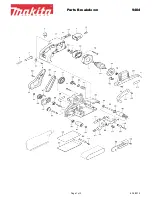
- 4 -
DESCRIPTION
1. Trigger
2. Lock-on button
3. Dust bag
4. Lever
5. Front roller
6. Abrasive belt
7. Adjustment knob
8. Rear roller
SPECIFICATIONS
Belt size
76 x 5 mm
No load speed
250 m/min
Frequency
50 Hz
Voltage*
0 V
Input
810 W
Over all dimensions
00 x 150 x 170 mm
Net weight
2.7 kg
* Be sure to check the nameplate on the product, because
the voltage is subject to change depending on the area in
which the product is to be used.
STANDARD ACCESSORIES
Dust bag, Abrasive belt
APPLICATIONS
(Use only for the purposes listed below.)
1. Surface finishing for wood.
2. For removal of rust and surface finishing for metal.
SWITCH (Fig. 1)
This tool is started and stopped by squeezing and releasing the
trigger (1).
For continuous operation, press the lock-on button () while
trigger is being squeezed. Squeeze trigger again to release the
lock.
DUST BAG (Fig. 2)
When sanding wood, the dust bag (3) should be used.
Although the dust bag has a substantial capacity, it should be
emptied frequently.
Opening the zipper of the dust bag allows complete cleaning.
CAUTION!
When sanding metal, the dust bag should not be used,
because of the risk of fire from flying sparks.
CHANGING THE ABRASIVE BELT (Fig. 3 to 5)
WARNING!
BE SURE TO DISCONNECT THE TOOL FROM THE POWER
SUPPLY WHEN MOUNTING AND REMOVING THE ABRASIVE
BELT.
1. Turn the tool upside down
and lift the lever (4) to retract the
front roller (5) and release the belt tension. (Fig. 3)
2. Pull the abrasive belt (6) off.
If the belt tension is not released after lifting the lever, loosen
the adjustment knob (7). (Fig. 4)
3. Mount a new abrasive belt.
Note!
Be sure that the arrow on the inside of the belt is
pointing in the same direction as that of the tool.
4. Push the lever down to the original position. (Fig. 5)
CAUTION!
Ensure that your fingers are not trapped.
TRACKING ADJUSTMENT (Fig. 6)
The belt life will be increased by using the tracking adjustment.
1. Turn the tool upside down and hold it firmly with one hand,
then start the tool and observe the tracking of the sanding
belt.
2. Stop the tool and adjust the tracking of the belt by rotating
the adjustment knob (7) until the edge of the belt is even
with the outer edges of both the front (5) and rear rollers (8).
CAUTION!
Check that the belt doesn’t rub against the tool’s frame.
OPERATION (Fig. 7)
NEVER COVER AIR VENTS SINCE THEY MUST ALWAYS BE
OPEN FOR PROPER MOTOR COOLING.
MAKE SURE THAT THE WORK PIECE IS FREE OF NAILS
AND OTHER FOREIGN OBJECTS THAT COULD TEAR THE
ABRASIVE BELT.
Hold the tool firmly with both hands. Turn the switch on and
permit the rotation of the abrasive belt to reach full speed. Then
gently place the tool on the work piece surface. Move the tool
back and forth. Never exert excessive pressure on the tool. The
weight of the tool applies adequate pressure. Excessive pressure
will retard the abrasive action, leave an uneven finish and cause
extra wear to both the tool and the abrasive belt.
Always lift the tool off the work piece before turning the switch off.
MAINTENANCE
After use, check the tool to make sure that it is in top condition.
It is recommended that you take this tool to a Ryobi Authorized
Service Center for a thorough cleaning and lubrication at least
once per year.
DO NOT MAKE ANY ADJUSTMENTS WHILE THE MOTOR IS
IN MOTION.
ALWAYS DISCONNECT THE POWER CORD FROM THE
RECEPTACLE BEFORE CHANGING REMOVABLE OR
EXPENDABLE PARTS (BLADE, BIT, SANDING PAPER ETC.),
LUBRICATING OR WORKING ON THE UNIT.
WARNING!
To ensure safety and reliability, all repairs should be
performed by an AUTHORIZED SERVICE CENTER or other
QUALIFIED SERVICE ORGANIZATION.
SAVE THESE INSTRUCTIONS FOR FUTURE REFERENCE.
Содержание EBS-810
Страница 1: ...6986198 STD 11 10 EBS 810...
Страница 2: ...2 1 3 4 5 1 2 3 4 8 5 3 1 4 5 6 4 5 6 7...
Страница 3: ...6 7 7 5 8...
Страница 6: ...NOTE...
Страница 7: ...NOTE...


























